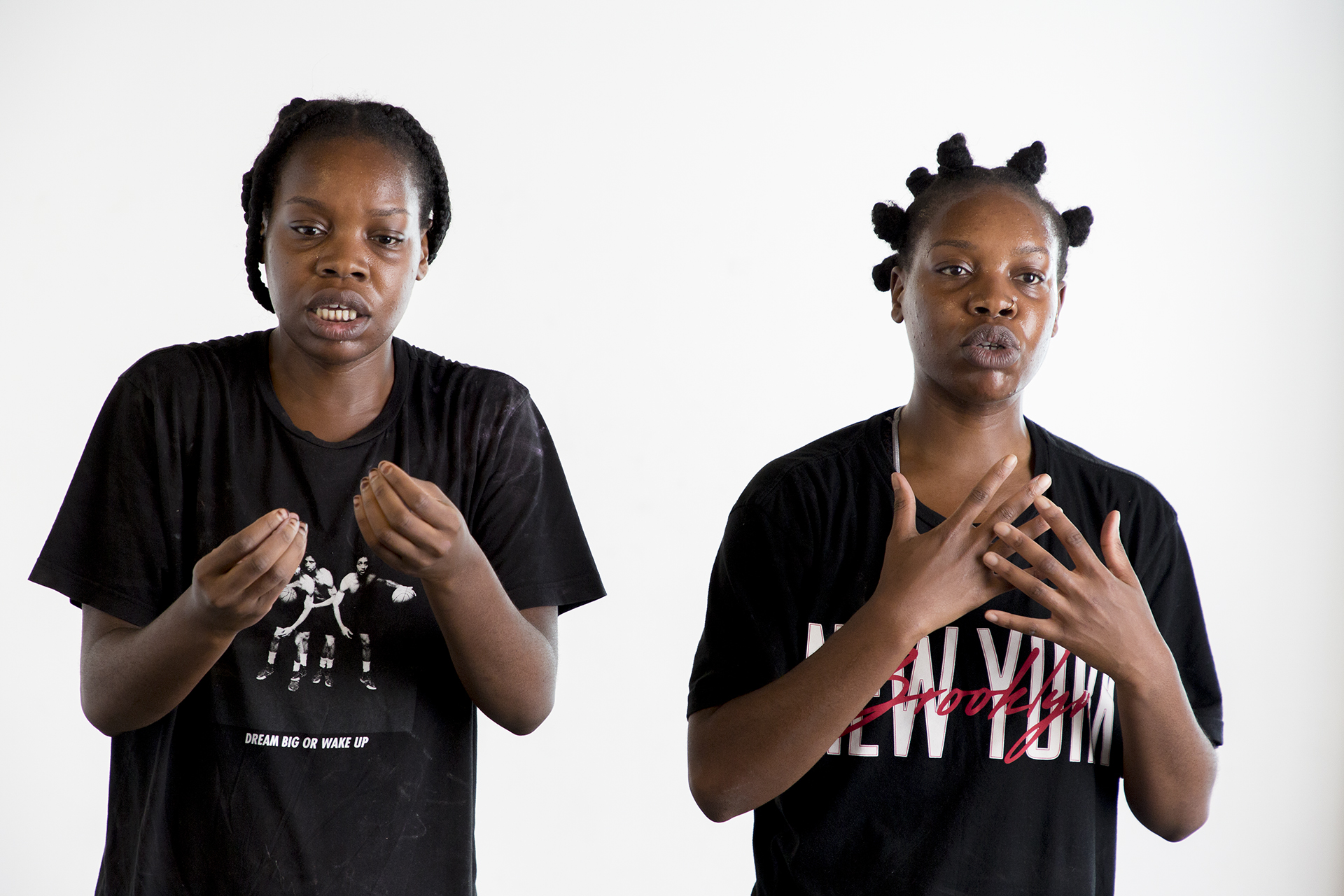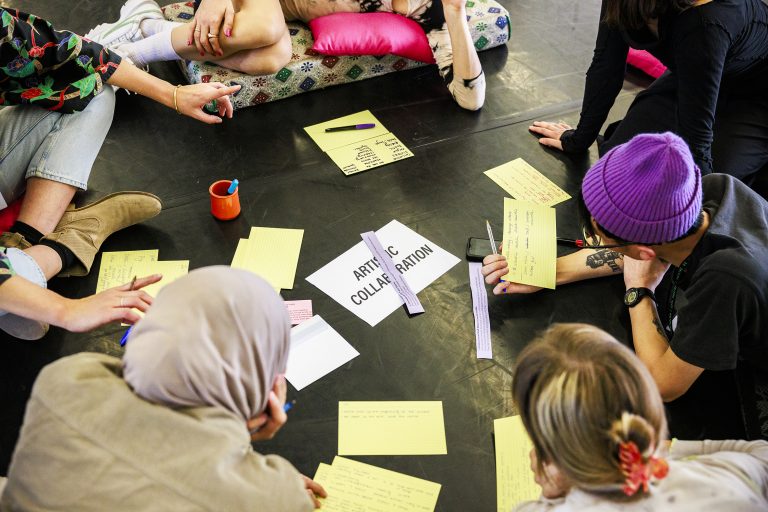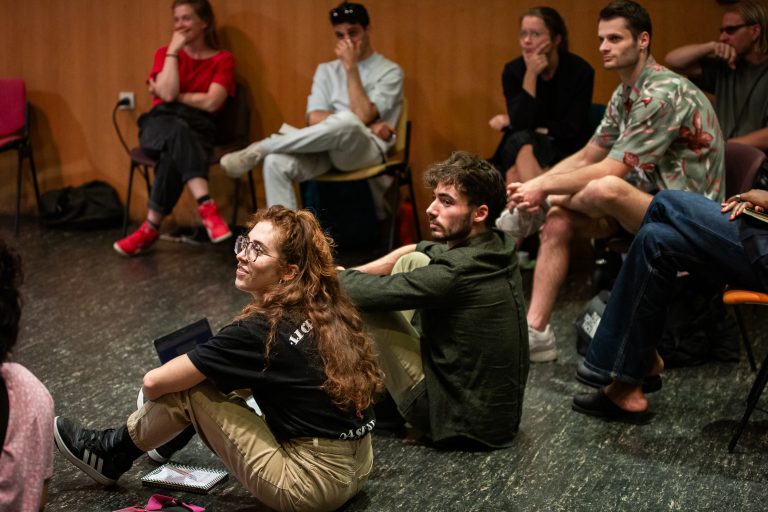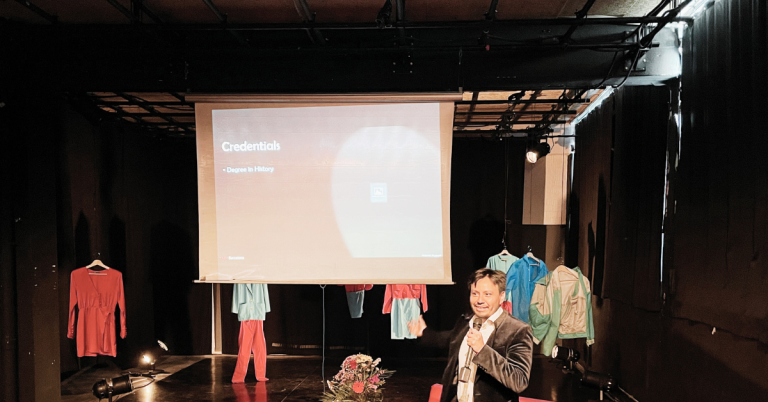
© Jordi Buxo
Tell a little more about yourselves.
Doris: “I am a professional dancer in different styles, such as urban, hip hop and house. Simply, it all started in 2010 together with my sister, Nathalie. We are real adventurers and love to travel so we went to New York with a huge enthusiasm to check out the dance world there. We danced there in different styles before other countries attracted us to visit. So soon we ended up in Senegal and Congo learning traditional dance and connecting with young people. In Senegal we learned Sabar and in Congo Tombolo, Mutuage. A huge learning experience.”
Nathalie: “Like Doris, I have been a dancer since 2010. We are originally from Congo but we currently live in Brussels. My love for food occupies a big part of my life. Not only do I love to eat all the good things the world has to offer but I also love to cook. Mainly the traditional food of our homeland such as pondu, fufu, fumbwa, matembele, fish makayabu… You name it, it’s all great. Not only has Congolese cuisine conquered my heart, but Moroccan or Italian cuisine can certainly charm me as well. And of course I love to go out and discover new dishes from different countries. To relax for a moment, I like to watch a movie on the couch. My love for international cuisines and traveling naturally go a bit hand in hand. Moreover, I love collaborating with other artists. Finally, my goal is to keep learning and growing. Today I proudly call myself a female artist. Of course there is still much to learn but I am immensely satisfied with where I am today.”
Ester: “I am a theater director and dramaturg. To be where I am today, I have walked many paths. I have already been an actress, a dramaturg, an educator and finally an assistant to an artistic director. In addition, I have had a career as a comedienne for 20 years. To get here I have already had to work extremely hard, but I would not change anything about my journey so far. As a female director, there are still few places so I really have to fight for my dream. I did my training in Barcelona and then Paris, in Jacques Lecoq. This is a school where hugely important people from all over the world come so to say it was an honor is an understatement. Thanks to the variety of people in this school, you get to know different cultures and languages. It has now been 18 years since I graduated and the memories still stick with me as if it was yesterday. By nationality, I am Andorran; I was born and raised in Andorra. This is a small independent, conserved country with its own government. When I told my parents in 1989 that I wanted to study theater, they thought it was rather strange. Mainly because at that time no one thought you could make this your job. Initially I wanted to become an actress. Of course this changed later but in the very beginning I knew little about the potential within the theater world. After a while I discovered that I wanted to direct and become a dramaturg. Hence, I made the choice to move to Barcelona to study theater here. I was the first woman from my home country to dare to take this step. Originally my parents were quite disappointed but today they are very proud. Partly because I opened doors for others, several of my compatriots from Andorra now dare to make the same life choice. I brought the world of theater to Andorra. Now, 30 years later, I can tell you with certainty that it is actually so.”
What is the name of your project?
Tell me more about what exactly it entails.
Says Doris, “We participated in WIPCOOP in 2017 and in 2021 we were invited by MAP to do an Artist Talk during a Work In Progress day at KVS. There, Ester heard us talk about our performance A travers l’autre. Before this whole project, we did not know Ester. Through Zoom, we met for the first time. The name “Le Vide” came about during our conversations. In Covid times, we were all actively looking but at the same time a little confused, hence the name ‘Le Vide’ or so the void translated.”
Ester: “There was a form of acceptance that as a society we were living in a kind of void because no one really knew what was going on. Our life as we knew it was turned upside down: the streets were empty, rehearsals were all done digitally. We went through this day in and day out and sincerely asked ourselves, “what is this? So we simply said, ‘If we feel we are in a void, let’s make that the theme: Le Vide.’
What does the name of this project mean to you, Ester?
Ester: “The moment we thought of it and accepted it, it was everything. Just life as a whole. It was a moment of activation. Let’s go with it and let’s take the void for what it is. It could be yet it could not. In the beginning, I didn’t even know what hip-hop was. When Tine (MAP), Nathalie, Doris and I decided to do this collaboration, I was in Barcelona. I had no possibility to take a flight because we were in lockdown. Personally at the time I thought ‘Okay, this will work’ but at the same time I thought ‘Oy, this can never work’. It was about 3 artists confronting the void. I had seen Nathalie and Doris before but they saw me, as mentioned just now, for the first time during the Zoom call. On reflection, it is not nothing to make a project with 2 hip-hop dancers and someone from Andorra. But we don’t say no to a challenge and so we went with it. As soon as we could, we flew in and met in Antwerp at Rataplan.”
And what does it mean to you, Nathalie?
Nathalie: “For me, it’s a representation of the lack of control. How a situation overwhelms you unexpectedly and how you have to deal with the emotions and consequences despite not having seen it coming.”
How did the research for this project go?
How did you get started on this?
Ester: “The priority was getting to know each other. This project could not start through Zoom during a pandemic. The official start took place in Antwerp, in Rataplan. That’s where we really met for the first time. That moment is a big part of our research. For me, it was necessary to start from scratch, to start without preparation so that we could begin in full honesty and transparency. Purely because this is about emptiness and because this was our theme, a fresh, raw start was of enormous importance to me. Then we drew up lists of feelings and movements that we connected to emptiness. In order to gain personal insight and in this way we could really begin our research. We met for 2 months, about 4 times, via Zoom before we met in person. Then, in March 2021, we spent 10 days together in Rataplan to work thoroughly on our project and do the necessary research.”
Who else is involved in this project?
Ester: “We started with team of 5 people: Mulanga, Charlotte, visual artist Younes, photographer Victoriano, and finally Tine.”
What was it like working with the three of you together?
What made it so special?
Nathalie: “The click with Ester was there from the first moment and it just felt right from the start. Like we had known each other for years. Since all three of us are artists, this made us feel more at ease during the initial stages of our project. For Doris and me, it did take us out of our comfort zone because as dancers we are not used to acting or talking in front of an audience. So sometimes it was a little uncomfortable for us but I am very happy that we went for it together and realized this together.”
Doris: “I concur with my sister. The connection during our first meeting was indeed great. We had a good laugh together and felt very good.”
Ester: “Our first meeting was magnificent. Finally we sat together in the rehearsal room. All I really knew about them was that they were hip-hop dancers, nothing more. So it was kind of exciting to present my ideas. I really thought they were going to throw their chairs at me (laughs). At that moment it was just a guess but there was actually an immediate connection. And surprisingly, they found all my proposals interesting and were open to everything. We were literally together 24/7 during those 10 days, mainly because the country was still in lockdown. So we couldn’t cozy up at a café or restaurant. But we treated each other like 3 sisters, with a healthy dose of respect and appreciation. We even shared intimate stories with each other despite our age and cultural difference. Despite the unusual circumstances, I wanted to take full advantage of this wonderful opportunity and the time we had together. I told them about Haikus, here they both immediately saw pleasure in this and we started working with that. We were really a group of strong women. There was a heartwarming caring among each other and so our project was able to grow nicely.”
Will you tell me more about your sources of inspiration?
Where do you guys get your inspiration?
Nathalie: “My biggest source of inspiration is my mother, a real role model. But of course also people from the dance world, like Alessandra Seutin, Zach and of course my sister Doris as well. Our oldest sister is not a dancer but she also inspires me a lot. In general, I get inspiration from the people I cross in my daily life. The way they talk, laugh, their energies.”
Doris: “Just like Nathalie, our mother is an inspiration to me. She brought me into this world and thanks to her I am the woman and person I am today. Someone with a strong personality. I can’t give you specific names because everyone inspires me. But the first one who inspired me was really my mother; she dances the traditional dance from Congo incredibly well. Besides dancing, she inspires me just by being who she is: a great mom and grandma.”
Ester: “I loved listening to Nathalie and Doris. Their generation is inspired by the people around them. And there is something very beautiful about that. In my time, our sources of inspiration were people like Michael Jackson and Marilyn Monroe (laughs). Currently, I draw inspiration from the people I have around me right now. I get inspiration from my project partners, Doris and Nathalie.”
What is the most important message you would like to convey to your audience?
Ester: “This project is a reflection of emptiness. Accept this concept, this feeling. Embrace it, live in the now and learn to enjoy Le Vide. Finally, I would like to take a moment to thank our other team members. They were extremely present and helpful. Victoriano took pictures during rehearsals when we were still really searching. With the pictures he took, Younes went to work and from these he made beautiful drawings. In addition, two musicians collaborated. Lluis Cartes created a first sound in Barcelona, and Kike added his sound afterwards in Brussels. Although we didn’t use all of their creations, they helped us enormously. They helped shape this project and for that we are enormously grateful.”
Nathalie: “As Ester just said, embrace and accept the situation during the void. The calmness that comes with it.”
Doris: “I totally agree with Ester and Nathalie’s message. And if I may give another tip: push your own limits.”
LE VIDE. An artistic investigation by Les Mybalés, Ester Nadal and MESTIZO ARTS PLATFORM in collaboration with Rataplan, KVS and the Brussels Capital Region, Nau Ivanow, Ultima Vez, Walpurgis and with the support of the Flemish Community and City of Antwerp
MORE INFO ABOUT LE VIDE, click HERE


